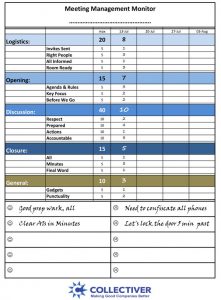You Don’t have to be Steve Jobs to Run Meaningful Meetings

Last week, I attended a meeting at an organization that I will not name here, although they will hardly ever read this because everybody in the organization is “crazy busy.” No wonder: about 20 people attended the meeting, half of them dissolved soon because they were “triple-booked,” and no decision or minutes followed, of course. They are permanently, desperately busy.
(For the desperately busy ones, here’s a TLDR VIDEO version of this article).
Steve Jobs was notorious for having his meetings small (what Jeff Bezos now calls a two-pizza meeting) and making sure that every person had something to contribute. Nothing to add? – Thank you very much, get out of here!
According to Ken Segall (“Insanely Simple: The Obsession That Drives Apple’s Success”), a corporate poster on “how to have a successful meeting,” if written by Steve Jobs, would rather look like this:
-
Throw out the least necessary person at the table.
-
Walk out of this meeting if it lasts more than 30 minutes.
-
Do something productive today to make up for the time you spent here.
As Apple’s agency founder, Jay Chiat, succinctly put it years before Steve:
“What are you guys doing here? … You shouldn’t be sitting around a table talking about this bullshit, go create something.”
Of course, those guys had the luxury of making the decision to discharge useless “spectators” on the spot without any personal danger. You may have less freedom but you can still make your meetings efficient. At least, you must try.
 Once, I was put in charge of a failing organizational performance improvement project. What shocked me the very first day on the project was the weekly “status” meeting that dragged on for two-three hours and had up to 22 directors on the attendee list. Citing schedule conflicts, I booked a smaller conference room and moved the meeting to 11:00 AM. Now we could only sit 10 people, and they would be anxious to leave for lunch at noon. That simple move made our meetings more effective, and the project got off the ground.
Once, I was put in charge of a failing organizational performance improvement project. What shocked me the very first day on the project was the weekly “status” meeting that dragged on for two-three hours and had up to 22 directors on the attendee list. Citing schedule conflicts, I booked a smaller conference room and moved the meeting to 11:00 AM. Now we could only sit 10 people, and they would be anxious to leave for lunch at noon. That simple move made our meetings more effective, and the project got off the ground.
Even if your meetings are already reasonably good, it makes sense to follow a few rules to keep them productive. You can achieve that by monitoring the meeting quality using a simple form and selecting one positive lesson learned (to perpetuate) and one critical area of improvement – to take care of by the next meeting. Keeping the score makes your progress measurable and thus more effective – and inevitably will demonstrate immediate improvement.
More on meetings:
